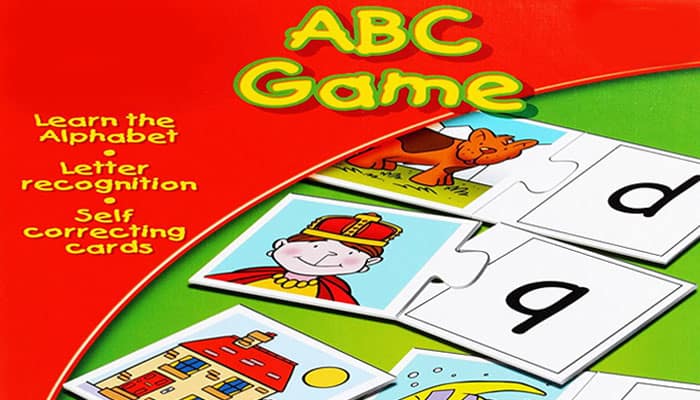

Components
- 26 pairs of cards
- Instructions
Setup
Before playing any of the games it's a good idea to look through all the cards with the children, talking about the objects and asking various questions:
- What is this?
- Have you seen one of these?
- What do you think this is for?
- Who would use that?
- Where would you find that?
Depending on the age of the children, some of the games can be played with only a few of the cards at a time. Cards that might prove too difficult should be left out.
To begin with the letters should be pronounced phonetically, i.e. how they sound. The actual names of the letters should only be introduced when all letters are known and their phonetic pronunciation has been mastered.
When first playing, it is a good idea to just use the front of the cards, showing the letter and the picture. The back of the cards showing upper and lower cases of each letter, can be used at a later stage.

Game Play
1. Sorting Pictures and Letters
The cards to be used should be separated out and all mixed up, with the picture side showing. Players now try to match up the correct pairs. This can either be done by one child at a time or by several in a group simultaneously.
The puzzle design of the cards means that only the correct picture will fit with any given letter.
Consequently, a child will see quickly whether or not he or she has made a correct pair. The words and letters should be spoken out loudly and clearly.
2. Card Swapping
The cards are dealt out equally. It doesn't matter whether a player has more letters than objects or vice-versa. Any player who already has a correct pair may lay it down in front of him or her.
The youngest starts by asking any other players for a card which they need to make a pair. They offer another card in exchange. If the swap is successful, the completed pairs are laid out in front of the players.
If not, the next player takes their turn. Playerscan decide whether or not they will allow a second question, if the first proves fruitless.
In this game it is not so much a matter of collecting the most pairs as enjoying and learning from the questions and answers game. For example "I have the card with the sun. I'd like the letter's "s" from you"
3. Question Game
The cards are dealt out equally and each player tries to keep his cards hidden from the others.
One child starts by asking any other player "Do you have the "c" for cat?" or "Please give me the picture which goes with "j". If the answer is positive then the card must be handed over.
A player can carry on asking as long as their question is successful. As soon as someone says "no" the next child takes their turn. A player can choose who to ask for whichever card he or she needs to make a pair.
Complete pairs are laid out on the table. The game can finish either when one child runs out of cards or when all pairs have been matched up. In both cases the winner is the player with the most complete pairs.
4. Partners
A game for larger groups of an even number.
The game is played with exactly half as many pairs of cards as there are players. Each child is given a card. Those with letters sit or stand opposite those with the objects.
The first child form one group asks those in the other group who has the matching card. For example "I have the letter "f". Who has the matching picture?"
The child with the fish card goes to the child with the letter "P. The questions carry on until everyone has found a partner.
This game can also be played in a large room. The children run around and look at each other's cards until all partners have been discovered.
Further variations of these games as well as many others, can be played with the cards. With a little imagination, no two games need be the same.
The words used in the games are:

The Learning Aspects of the Games
Playing these games, an inquisitive child can learn a great deal:
- Recognition and naming of people, animals and objects from the world around him or her.
- Recognising that the names of these things can be written down as words.
- Listening to, differentiating between and pronouncing the various sounds.
- Recognizing the first letters of words.
- Learning that sounds are represented by letters.
- Sorting out letters and sounds.
- Getting to know and differentiate upper and lower case letters.
Continue Reading

